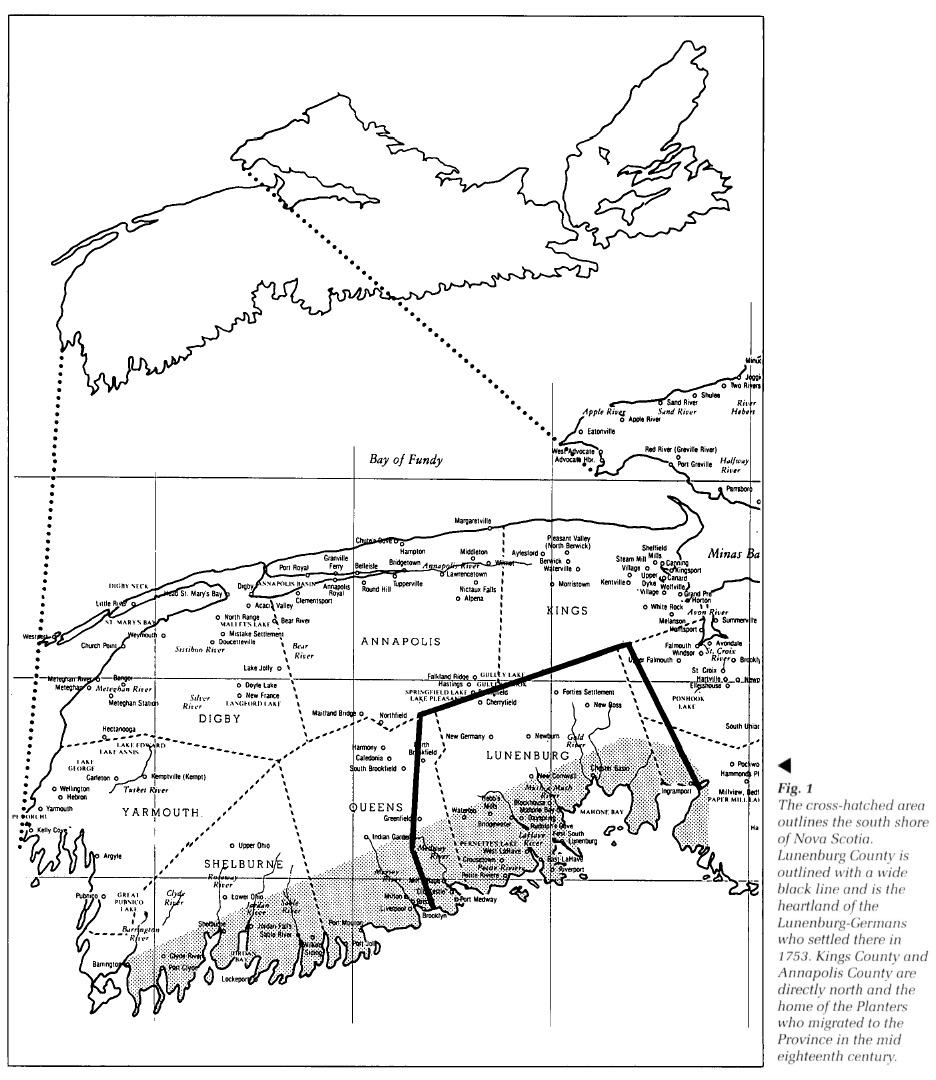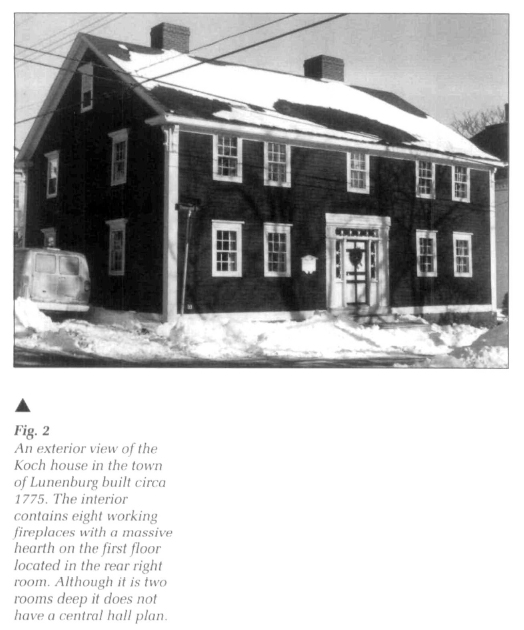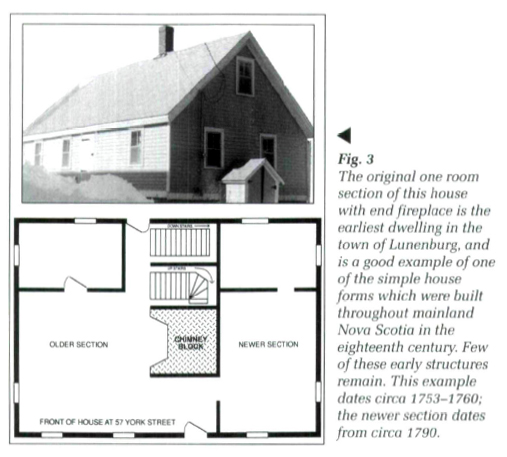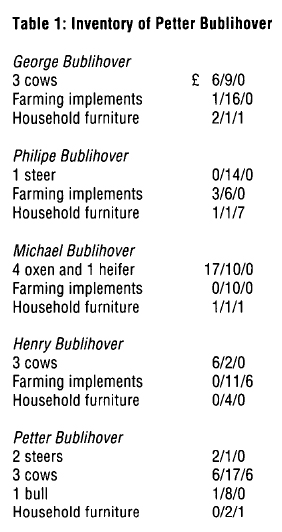Research Reports / Rapports de recherche
Domestic Life in Eighteenth-Century Nova Scotia:
A Rural Perspective Based on Lunenburg County and Kings County Yeoman Probate Records
Rethinking the Architectural Landscape
1 In the 1795 diary of the Reverend James Munroe, a travelling missionary of the Church of Scotland, he notes that, "The town of Lunenburg itself is but a small place — about seventy-three dwelling-houses. The houses are commodious enough, but not elegant."1 Munroe's impressions of the Lunenburg house are revealing. There is little question that they had spacious interiors. For example, in the diary of Leonard Christopher Rudolf, who describes his residence as "small, but strong," he states that on 27 December 1781 his eldest son was married in his house to Elizabeth Koch, the daughter of the miller Henry Koch, and that the wedding was attended by 47 people!2
2 Although we do not know what Munroe's concept of elegance was, or on what dwellings he based his assessment, there is little doubt that many of the rural houses of Lunenburg and Kings County,3 and by extension mainland Nova Scotia (Fig. 1), were indeed decorated and full of variety and architectural detail. In fact, the house of Henry Koch (Fig. 2) is still standing and little changed on both the exterior and interior. Dating from 1775, this dwelling remains one of two of the town of Lunenburg's finest surviving eighteenth-century residences. The other is the Knaut-Rhuland house.4 (See article on this house elsewhere in this issue).
3 In Kings County, similar eighteenth-century late colonial/Georgian style residences also exist, including the Atwell house dating from 1770.5 Other houses with a gambrel roof, known to have been largely developed in New England and transferred to Nova Scotia with the Planter migration, also survive. Two of the finer examples of this style include the Calkin house and the Stephen Loomer house.6 However, the gambrel-roof style house is not strictly confined to Kings County or the Planter region of the Annapolis Valley, but is also found in the town of Lunenburg. The Romkey house remains one of the most intact surviving examples of this form dating from 1765-1770. Until the late 1960s another fine example remained near the Romkey residence, but this was destroyed to make way for a parking lot.7
4 All of these houses existed at the time of Monroe's visit to Lunenburg. However, the good Reverend's observations suggest a more austere architectural landscape, not only in the town of Lunenburg itself, but in the rural countryside of both Lunenburg and Kings County.
5 Recent studies by Michael Steinitz on housing in eighteenth-century Massachusetts is leading to a total reevaluation of architecture in that state, which according to Steinitz was a landscape "... characterized by much smaller and meaner dwellings than has been assumed up to this point."8 In other words, the Massachusetts/New England countryside did not consist entirely of "elite" colonial house styles, but was composed of many more smaller structures that simply did not survive the last two centuries, or were not sturdy or adaptable enough to be incorporated into later more elaborate houses.
6 Evidence from eighteenth-century probate records for Lunenburg and Kings County suggests that the architectural terrain consisted of dwellings which were much simpler and meaner in both external appearance and interior room configuration, and that the furnishings and domestic settings in many of these houses reflect the plainness and severity of eighteenth-century material life in Nova Scotia.
 Display large image of Figure 1
Display large image of Figure 1 Display large image of Figure 2
Display large image of Figure 27 Houses such as Loomer and Calkin in Kings County, and Koch and Knaut-Rhuland in the town of Lunenburg, were actually endpoints in the development of eighteenth-century Nova Scotia architecture, and were normally the residences of well-to-do merchants and tradesmen. For example, in Kings County, the Planter architectural landscape underwent a developmental sequence which repeated the house cycle found in Rhode Island and Connecticut. This process saw the building by Planter settlers of the simple hall/parlour house plan still in use in the colonies from which many of the Planters originated, but beginning to decline as a common house form except in the most rural areas.9
8 A similar sequence of development is found in the town of Lunenburg, but the process is not the result of the transfer of earlier architectural styles from continental Europe. Rather, it is an architectural progression that started with the settlement of the town and surrounding countryside by the Lunenburg-Germans in 1753. This cycle begins with what have been described as "good framed Houses,"10 some of which were half-house structures consisting of one large room dominated by an end-wall fireplace, and others built on the one room deep hall/parlour plan. But the architectural development was rapid and by 1795 the town boasted dwellings such as the Koch and Knaut-Rhuland houses.
9 The only surviving example in the town of one of these "good Framed Houses" based on the half-house configuration is at 57 York Street (Fig. 3). Dating from 1753-1760, the post and beam plank-wall structure sits on a fieldstone foundation and consists of two sections constructed at different times. The original section of the house contains a massive chimney serving one fireplace on the main floor with a narrow staircase winding around the chimney to the attic space above and cellar below.
10 Early construction details include adze-hewn floor joists with members joined using a tusk tenon joint where the tenon member is notched into the mortise member for additional support; post and beam plank walls, and hand-hewn roof rafters pegged together and set on four-foot eight-inch centres. These in turn support one-inch (2.5 centimetres) thick vertical roof boards on the original house. The roof boards on the newer section are three-quarters-inch (1.9 centimetres) thick. Throughout the original house there is other evidence supporting a mid eighteenth-century date including pit-sewn boards, hand-forged nails and spikes, and early eighteenth-century hardware.11
11 The interior configuration of the York Street house is based on a simple one-room plan on the first floor (with a smaller divided living space in one corner, probably used as a bedroom), and sleeping loft above, and is dominated by the large chimney block. This would have been built originally on the end of the house, but became centrally located when the newer section was added.
12 Before 1800 in rural towns such as Lunenburg, there would have been a mix of house styles ranging from simple one room structures, to hall/parlour plans, to gambrel-roofed dwellings, to Georgian residences such as Knaut-Rhuland. All of these types of houses would have existed among the 73 dwellings commented on by Reverend Munroe in 1795.
13 In the surrounding countryside in both Lunenburg and Kings County, the architectural landscape was more austere, and many one-room structures and hall/parlour houses simply have not survived to the present day. Evidence supporting this suggestion is found in the probate records. The eighteenth-century rural architectural landscape of mainland Nova Scotia was one of harsh reality and contrasting domestic settings.
 Display large image of Figure 3
Display large image of Figure 3Yeoman Domestic Interiors
14 There are undisputed levels of domestic consistency between the eighteenth-century yeoman households of Lunenburg County and Kings County, regardless of their respective Planter and Lunenburg German origins — a shared domestic life that can be identified in all of rural mainland Nova Scotia from the mid-eighteenth century to the first quarter of the nineteenth century.
15 By using the 91 inventories studied for Kings County between 1761 and 1797 with an average estate worth of 31 pounds and ten shillings, and 122 of the Lunenburg County records between 1763 and 1808 with an average estate worth of 39 pounds and 9 shillings, it is possible to draw some definite conclusions about how these yeomen furnished and decorated their domestic interiors.12
16 The average eighteenth-century yeoman household contained: one or two beds with bedding, one or two chests with drawers and boxes without drawers, one to four tables, two to six chairs (in Lunenburg County benches are also listed), tools, iron and/or brass pots and kettles, andirons, trammels, pewter, linen and/or woollen wheels, tin and sometimes brass candlesticks, devotional works including bibles and song books, earthenware, textiles including wearing apparel, tablecloths, bedding and occasionally coverlets, woodenware including wooden storage containers such as firkins, and rarely a more "elite" cultural object such as a looking glass.
17 This basic inventory of furnishings suggests a very simple domestic setting, which allowed the yeoman and his family to maintain a socially acceptable standard of living avoiding the road to social disfranchisement. Some yeoman families attempted through other skills such as carpentry or weaving to augment their income and thereby afford space-enhancing household objects such as looking glasses, or even more elaborate furniture forms such as chests with drawers.13
18 An examination of several yeoman inventories from both Kings County and Lunenburg County will help to illustrate the material simplicity of many of these households. The Petter (Peter) Bublihover inventory taken in New Dublin in Lunenburg County in October 178914 demonstrates very clearly the marginal lifestyle many yeomen lived, and the attitude of some yeomen-farmers to material possessions. At the time of his death Peter was survived by his wife, five sons, and two daughters. Although his estate inventory is not detailed, it does provide information on the provisions he made for his children and his wife. The daughters and the widow Bublihover kept a bed and bedding and some kitchen items. The sons, however, divided the remaining estate in a family-style auction.15 The way in which the items are listed, and the prices paid for them by Peter's sons, suggest the relative importance of material goods and help to explain the yeoman attitude toward the material world. Table 1 lists the items purchased by each son and the prices paid.
19 It is obvious from the inventory that livestock and farming implements were the most important items to the Bublihover sons, reflecting their occupation as yeomen-farmers. The total value of the livestock was £40/19/6, farm implements £6/3/6, and household furniture only £4/10/6. This suggests that the Bublihover family lived a marginal existence placing great importance on the farm animals — highly significant to their way of life and ability to survive.
20 The life of the Bublihovers, like that of most yeomen-farmers, was governed by an exhaustive and repetitive pattern that demanded the performance of the same tasks and household chores year after year from early morning to late at night. This cycle of activity was determined by the changing seasons and the inevitable and unpredictable fluctuations in weather. Day after day, month after month, the same tasks would be repeated. For a yeoman family unable to decorate their domestic interior with certain comforts and objects that reflected success, life was demanding and stressful, leading toward possible social disfranchisement.
21 The value and importance of livestock is common to almost all yeoman inventories throughout mainland Nova Scotia. Some families, however, were able to afford space-enhancing objects and placed higher importance on household furnishings. For example, in the November 1767 inventory of Jeremiah Baker of Newport, Kings County, who migrated from Newport, Rhode Island, in 1767,16 a low case of drawers and one chest was valued at ten pounds, while two cows were appraised at £8/0/0, and one bed, one coverlet, two blankets, one pillow and one old bedstead at £2/0/0. The total valuation of the Baker estate was £31/12/0.
22 The same attitude toward furnishings is true of the Stephen Chapman inventory taken in November 1770, and valued at £35/14/0. A neighbour of Baker's who also migrated in 1761 from Newport, Rhode Island,17 the inventory listed three complete beds and bedsteads with bedding valued at £2/10/0, £2/0/0, and £1/0/0 respectively, indicating the importance of beds as a furniture form (see note 23). This same inventory also places high values on livestock with one mare and colt, three cows, and one sow and three goats all appraised at £9/0/0.
23 But what about the consumer attitudes of "middling" yeomen, perhaps in social transition from yeomen-farmers to yeomen-craftsmen, with estates worth more than their poorer neighbours. Families who were not on the road to social disfranchisement were able to afford elaborate furnishings with which to decorate their household because of their ability to augment their farming income with other skills.
24 In March of 1775, George Mumford and Woodward Sanford went to the home of widow Card to inventory the worldly possessions of the late Richard Card of Newport, Kings County. In his will Richard Card refers to himself as yeoman.18 Born on 11 January 1717, he was the son of Joseph and Hope Card of Kingston, Rhode Island. Married twice, he died on 12 March 1775 with an estate worth £78/18/0.19
25 As court-appointed inventory takers, Mumford and Sanford were meticulous in their duties. Beginning in the farmyard and barn they listed Card's livestock, including two oxen valued at £12/10/0, and two cows at £8/0/0. Completing their task in the farmyard, they moved into the house and began listing Card's domestic furnishings room by room.
26 The Card inventory is one of the earliest Planter documents found to date that gives a room-by-room record of furniture and accessories. The Card dwelling consisted of three rooms identified by the inventory takers as the "westerly room," the "easterly room" and the "chamber." This terminology describes a simple structure, the most plausible configuration being a one-room deep hall/parlour plan with sleeping chamber above.
27 When Mumford and Sanford left the farmyard and entered the house in what they called the "westerly room," they found: wearing apparel, one case of drawers, one chest, pewter including dishes, plates and spoons, one looking glass, and one featherbed, bedstead and accessories. This room contained the best furnishings and was used for multi-functional family activities including sleeping, as a dressing room, and for dining and entertaining.
28 The presence of the case of drawers valued at £6/5/0 helps to illustrate Card's social position and wealth. In New England "...by the early years of the eighteenth century, chests of drawers could be found in the homes of wealthy merchants and in the homes of artisans and yeoman farmers of middling status."20 The same is true of looking glasses. During the mid-eighteenth century a relationship between the ownership of a looking glass and wealth persisted.21
29 Moving into the "easterly room," Mumford and Sanford entered the kitchen, which was furnished with: iron pots and one iron kettle, one pair of andirons, one pair of candlesticks, one pair of tongs and two iron trammels, buckets and barrels, one brass warming pan, and a large quantity of carpenter's tools including saws, and various planes. It is this last item that indicates that Richard Card had the tools and skill to increase his income as a farmer by working as a carpenter during die "off-season," lifting his family into the category of yeoman-craftsman.
30 Completing their task in the chamber, the inventory takers listed a bed, bedstead and accessories, suggesting its sole function was for sleeping.
31 Although it is impossible to determine what furnishings were removed from the Card household by his family prior to the taking of the inventory, the absence of any listing for tables and chairs is curious. If they were removed by Card's wife and/or children this would suggest that they had a higher "social" value than the looking glass, chest, case of drawers, and pewter that were left behind — a highly unlikely possibility. The obvious explanation is that the Card household contained neither chairs nor tables, and that chests and built-in furniture forms were used for these purposes.22
32 The fact that Card owned neither of these furniture forms should not be considered unusual. Of the 91 Kings County records examined for this article, 11 do not list tables or chairs, which represents 12 percent of the total, a figure that is in keeping with inventory studies for the same time period in New England.23
33 Richard Card, at the time of his death, was a yeoman who lived in a simple house and exercised control over his domestic space. He was able to furnish his parlour with elaborate furnishings, and use it for social display and entertaining, and to some degree influence the thoughts and actions of his guests. Card was more interested in objects that enhanced his social position and allowed him to further "control" his domestic environment. Therefore, rather than tables and chairs he owned a looking glass, chest, and case of drawers.
Conclusions
34 The study of eighteenth-century domestic life, architecture, and the lifestyles of merchants, yeomen, and artisans in Nova Scotia, is still in the formative stages. Although this is a preliminary study to a more thorough investigation and publication on material life in Nova Scotia between 1760 and 1820, there seems little question that the architectural landscape must be reexamined in light of Steinitz's research, and the evidence presented in the rural inventories for all counties in mainland Nova Scotia. Many of the simple one room, and hall/ parlour dwellings, simply did not survive into the twentieth century. What has endured are a few of these early style structures, and numerous more "elite" late eighteenth- and early nineteenth-century house forms that were the residences of merchants, artisans, and well-to-do yeomen. Much of the thinking and research carried out to date in Nova Scotia has been influenced by this distorted view of the architectural landscape.
35 Simple houses and room configurations produced austere domestic interiors for the poorer yeomen, while some of the "middling" yeomen lived without certain basic furniture forms such as tables and chairs to be able to afford more elaborate objects such as looking glasses and chests. Some yeomen were becoming socially disfranchised as they fell deeper into poverty, while others were attempting to improve their social standing by augmenting their farming income with additional skills, giving rise to a yeoman-craftsman group.
36 There is no question that it is very difficult to determine the social attitudes, assumptions and aspirations of a particular family or group strictly on the basis of domestic furnishings listed in estate inventories. Even records that give detailed room-by-room listings of objects, allowing for a better understanding of the domestic configuration of the house, must be used with caution. However, in mainland Nova Scotia the material and lifestyle differences between yeomen-farmers, yeomen-craftsmen, artisans, tradesmen, and merchants is more obvious than in New England. Part of the reason for this is the simple fact that the contrasts between these groups are more sharply defined in terms of the types of objects found in the household, and the substantial differences in estate valuations. Using the existing architectural record adds additional weight to the social differences between these groups.
37 Using architectural evidence in combination with probate records to develop a deeper understanding of eighteenth-century Nova Scotia is not without its pitfalls. While some building types may be recognized and interpreted from the probate inventories, others will never be understood because no models exist, and archaeological investigation into eighteenth-century houses in the province is non-existent. It is essential that documentary and physical evidence go hand in hand in attempting to accurately recreate the distinct and diverse architectural landscape and material life in Nova Scotia.
